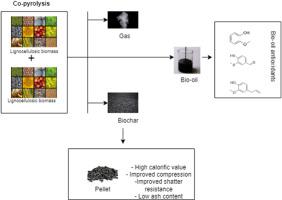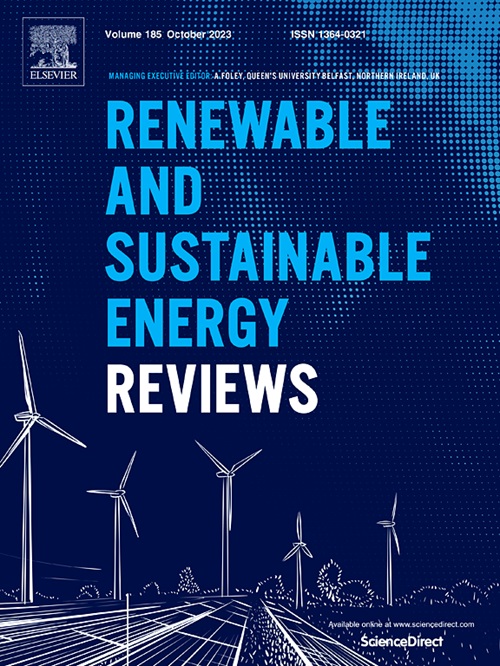利用农业生物质共热解技术生产抗氧化添加剂和生物炭颗粒:综述
IF 16.3
1区 工程技术
Q1 ENERGY & FUELS
引用次数: 0
摘要
缓解环境退化和全球变暖威胁的灵丹妙药之一是采用生物能源;这可能是化石燃料的替代品。热化学工艺是将生物质转化为生物燃料的可行方法。然而,生物质热解产生的生物油仍然无法满足美国测试和材料协会对石油产品的要求。因此,有必要采用更好的替代方法--共热解。这种能耗较低的技术有助于降低生产成本,缓解一些废物管理问题,并增加热解产品应用的种类和质量。只要稍加调整,共热解产生的生物油就可以转化为原油。通过共热解,农业生物质有望生产出重要的抗氧化化合物和生物炭颗粒,同时解决废物管理和可持续发展问题。生物炭是共热解的主要副产品之一,可作为稳定的碳汇,有助于固碳和减缓气候变化。此外,生物炭颗粒作为一种生物燃料,因其能量密度高、排放量小,可作为化石燃料的绿色替代品。共热解工艺不仅能将农业废弃物转化为经济上有用的产品,还能促进环境的可持续发展和社会经济的增长。尽管迫在眉睫的挑战是将生物油升级用于商业目的的成本,这也是生物油广泛使用的主要障碍之一。本研究概述了农业生物质类型、共热解过程、关键影响因素、副产品特性、作为抗氧化添加剂的生物油以及生物炭颗粒。本文章由计算机程序翻译,如有差异,请以英文原文为准。

Production of antioxidant additives and biochar pellets from the Co-pyrolysis of agricultural biomass: A review
One of the panaceas to mitigating the menace of environmental degradation and global warming is the adoption of bioenergy; a probable alternative to fossil fuels. The thermochemical process is a viable approach that converts biomass into biofuel. However, bio-oil produced from biomass pyrolysis still lacks the fuel qualities required to satisfy the American Society for Testing and Materials requirements for petroleum products. This therefore necessitates the adoption of a better alternative, co-pyrolysis. This mild energy consumption technology has helped lower production costs, alleviated some waste management problems, and increased the variety and quality of pyrolysis product applications. With a little adjustment, bio-oil generated by co-pyrolysis can be converted to crude oil. Through co-pyrolysis, agricultural biomass presents an exciting prospect to produce essential antioxidant compounds and biochar pellets while addressing waste management and sustainability concerns. Biochar, one of the major by-products of co-pyrolysis serves as a stable carbon sink, aiding with carbon sequestration and climate change mitigation. Moreover, biochar pellets, as a biofuel, provide a greener alternative to fossil fuels due to their high energy density and minimal emissions. The co-pyrolysis process not only converts agricultural waste into economically useful products but also contributes to environmental sustainability and socio-economic growth. Albeit the imminent challenge is the cost of upgrading bio-oil for commercial purposes, which is one of the major obstacles to its widespread usage. This work offers an overview of agricultural biomass types, the co-pyrolysis process, key influencing factors, byproduct characteristics, bio-oil as an antioxidant additive, and biochar pellets.
求助全文
通过发布文献求助,成功后即可免费获取论文全文。
去求助
来源期刊

Renewable and Sustainable Energy Reviews
工程技术-能源与燃料
CiteScore
31.20
自引率
5.70%
发文量
1055
审稿时长
62 days
期刊介绍:
The mission of Renewable and Sustainable Energy Reviews is to disseminate the most compelling and pertinent critical insights in renewable and sustainable energy, fostering collaboration among the research community, private sector, and policy and decision makers. The journal aims to exchange challenges, solutions, innovative concepts, and technologies, contributing to sustainable development, the transition to a low-carbon future, and the attainment of emissions targets outlined by the United Nations Framework Convention on Climate Change.
Renewable and Sustainable Energy Reviews publishes a diverse range of content, including review papers, original research, case studies, and analyses of new technologies, all featuring a substantial review component such as critique, comparison, or analysis. Introducing a distinctive paper type, Expert Insights, the journal presents commissioned mini-reviews authored by field leaders, addressing topics of significant interest. Case studies undergo consideration only if they showcase the work's applicability to other regions or contribute valuable insights to the broader field of renewable and sustainable energy. Notably, a bibliographic or literature review lacking critical analysis is deemed unsuitable for publication.
 求助内容:
求助内容: 应助结果提醒方式:
应助结果提醒方式:


